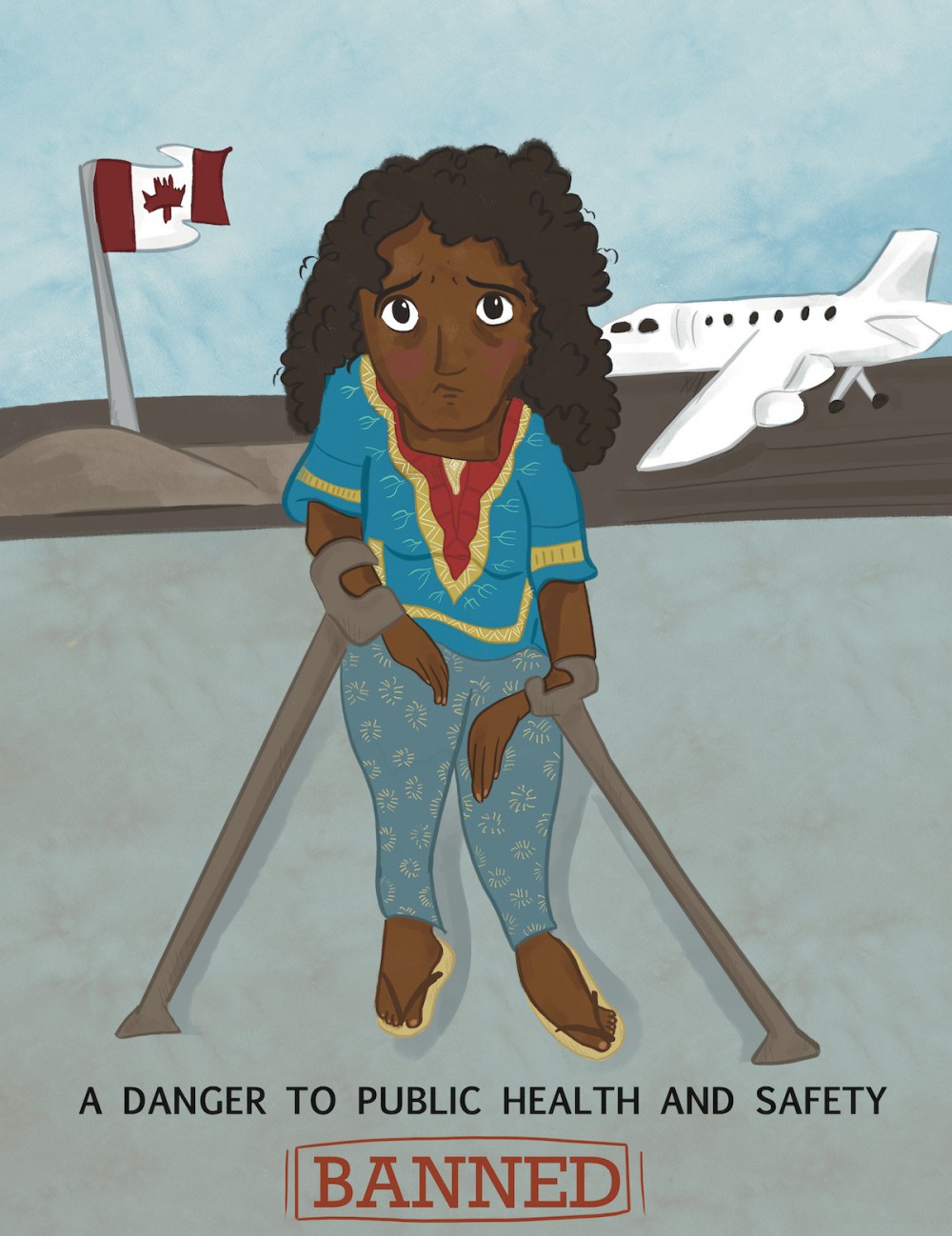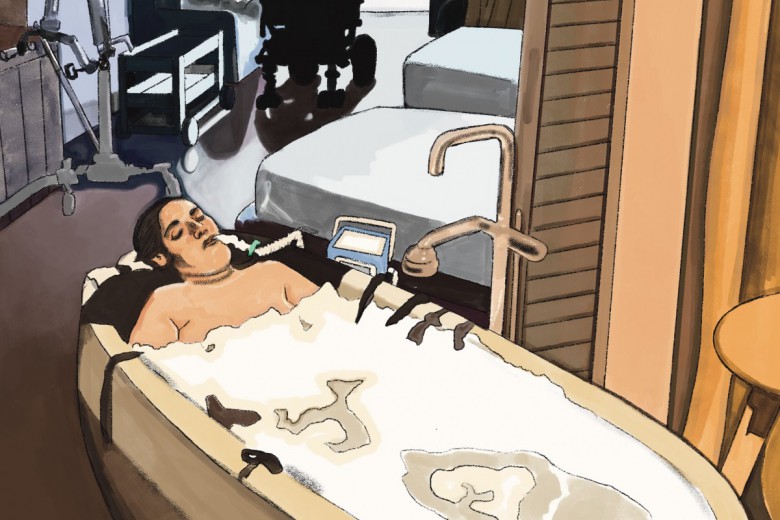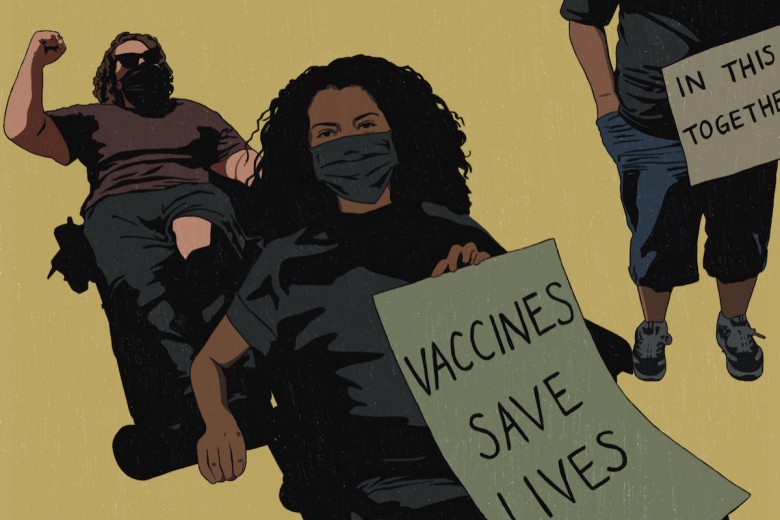
Naheen Ahmed
Plain language summary (What is this?)
- Ameil Joseph, a scholar who studies disability and migration, writes about the history of disabled people migrating to Canada, and the challenges they face.
- For over a century, the Canadian government has tried to keep people of colour, poor, and disabled migrants out of the country.
- In the early 1900s, Canadian politicians were worried that people of colour would replace white people. They wrote laws to prevent some migrants from living in Canada. For example, medical officers were allowed to deport migrants they considered “Lunatic, Idiotic, Deaf and Dumb, Blind or Infirm” if the migrants did not have family members who could take on responsibility for all their needs.
- Today, our immigration system still discriminates against disabled people. Disabled people are banned from immigrating to Canada if the Canadian government thinks their disability would cause “excessive demand” on health care or social services systems in Canada.
- Many people and groups are fighting against this discrimination. They are working to stop deportations, free immigrants from prison, and remove the “excessive demand” policy.
In March 2020, governments around the world began implementing travel restrictions to prevent the spread of COVID-19. While Canadians were told to “shelter in place,” 82.4 million people were displaced in 2020 worldwide due to persecution, conflict, and violence. In Canada, the federal government established travel advisories for China and South Korea, and between March 21, 2020, and June 2021, forced 444 people seeking asylum back to the United States, ostensibly in order to protect Canadians from COVID-19.
Discriminatory immigration bans to “protect Canadians” aren’t unique to the pandemic – they have a long history in Canada. From the Chinese Head Tax to the Komagata Maru “incident,” the Canadian government has long sought to exclude racialized, poor, disabled, or otherwise “unworthy” migrants and continues to do so. To better understand how the Canadian immigration system treats disabled migrants, Briarpatch spoke with critical disability and migration studies scholar Ameil Joseph, who shares some background on immigration policies, and how to fight the ableist and racist system.
BP How is the Canadian immigration process different for disabled migrants?
AJ To immigrate to Canada, one must be considered a skilled worker, be sponsored or nominated (by family or a province or territory, respectively), be a caregiver for a Canadian citizen, have started a business in Canada, qualify for special programs like the Rural and Northern Immigration Pilot program or the Agri-Food Pilot program, or qualify as a refugee. An immigration medical examination (IME) is also required. Disabled people are restricted by law from immigrating to Canada if their condition is deemed as one that “might reasonably be expected to cause excessive demand on health or social services in Canada.” “Excessive demand” is defined in terms of cost and burden. Specifically, if a newcomer or potential newcomer might cost more than $24,057 per year in health and or social services, the Canadian government can deem them inadmissible. In addition to cost, ”excessive demand” also includes “a demand on health services or social services that would add to existing waiting lists and would increase the rate of mortality and morbidity in Canada as a result of an inability to provide timely services to Canadian citizens or permanent residents.” Canadian immigration legislation also uses the language of “danger” to public health and safety as a consideration for medical inadmissibility.
When migrants are detained in Canada, they’re often incarcerated in immigration detention centres – and here, too, disabled migrants face appalling treatment. In 2021, Amnesty International and Human Rights Watch issued a report showing that Canadian immigration detention discriminated against detainees with mental health issues. The report found that immigrants with mental health issues are more likely to be imprisoned, are often barred from making their own decisions about legal matters, are more likely to have restrictive release conditions, and in Ontario they’re often put in solitary confinement for 15 days or more (which authorities call receiving “specialized care”). “Put simply, authorities often view psychosocial disabilities as a risk factor; instead of receiving vital support, immigration detainees with psychosocial disabilities receive disproportionately coercive treatment,” the report notes.
Canadian immigration legislation also uses the language of “danger” to public health and safety as a consideration for medical inadmissibility.
BP Are these types of policies new? Where do they come from?
AJ The use of immigration, medical inspection, and criminal justice systems to restrict, detain, and remove disabled people stem from historical ideas that continue to advance racialized and eugenic rationales. In the early 1900s, politicians inscribed these ideas into policy and law in Canada, worried about “race suicide” and that racialized immigrants would eliminate the white race. Today, that idea lives on in the “the great replacement theory,” a fallacy relied upon by white supremacists to suggest that there is some sort of conspiracy to replace white people with non-white immigrants. The great replacement theory is a campaign to embolden white supremacists and white nationalists and to influence mainstream public opinion by wielding the bigoted idea that white people are the reason for all historical, social, and political progress and that immigrants, disabled, and racialized people are the cause of all social ills.
As human rights scholar Ena Chadha has documented, as early as 1859 – pre-Confederation – a statute entitled “An Act Respecting Emigrants and Quarantine” included attention to immigrants labelled with intellectual/developmental disabilities. The Act allowed medical officers to target people they considered “Lunatic, Idiotic, Deaf and Dumb, Blind or Infirm” and deport them if they didn’t belong to an “emigrant family” (a family planning on immigrating to Canada) and were “likely to become permanently a public charge.” This enabled immigration officials to deport people who need care and support due to disability or mental health issues if they did not have a family member or members who could take on any and all responsibility for their needs. Other scholars, like Angus McLaren and Ian Dowbiggin, have documented the ways in which psychiatric and medical professionals advocated for eugenic policies to restrict the lives of disabled people – impeding their immigration, marriage, use of charitable and social service resources, and permitting their deportation and sterilization. These policies came from the ideas of racial hierarchy and the notion that disability, criminality, mental health, disease, and poverty are caused by biological traits.
In Canada, these eugenicist ideas were (and continue to be) driven by a false belief that immigrants are carriers of some sort of hereditary, biomedical inferiority or defectiveness. These ideas informed the “Prohibited Classes” section of the Immigration Act of 1910, which prohibited immigration to Canada for people deemed “mentally defective,” “Diseased,” “physically defective,” “Criminals,” “Prostitutes and pimps,” “Procurers,” “Beggars and vagrants,” “Charity immigrants,” and “Persons not complying with regulations.”
The legacies of these ideas continue to have impacts on our contemporary immigration practices.
These policies came from the ideas of racial hierarchy and the notion that disability, criminality, mental health, disease, and poverty are caused by biological traits.
BP Once disabled migrants arrive, how are they treated? What rights do they have?
AJ Newcomers to Canada often experience delays when they are waiting for confirmation of their eligibility for health care. The Interim Federal Health Program has also been amended since 2012 to further limit service eligibility. This results in hundreds of thousands of newcomers across Canada without adequate health care coverage, which also leads to mental health concerns and advanced illness. Barriers to health care are exacerbated by barriers to housing, employment, and education for newcomers which disproportionately impact disabled newcomers.
At the same time, politicians are considering expanding medical assistance in dying (MAiD) to minors and those who are not at or nearing end of life. The federal government is framing the expansion of MAiD as progressive, and allowing people to “die with dignity,” but disabled activists say that until disabled people can access equitable health care, housing, and income supports, MAiD is coercing poor disabled people into dying. Federal and provincial governments continue to refuse and deny adequate resources and care to disabled people and conceptualize their lives as unworthy of care. This is an issue that may heavily impact disabled migrants, who often experience barriers accessing health care, housing, and income supports.
This results in hundreds of thousands of newcomers across Canada without adequate health care coverage, which also leads to mental health concerns and advanced illness.
BP How do we fight against Canada’s racist and ableist immigration system?
AJ These discriminatory policies, practices, and laws have been challenged since they were first conceived. Chinese railway workers went on strike to protest the Chinese Head Tax, and after Canadian immigration officials turned away passengers of the Komagata Maru in 1914, South Asians protested the racist immigration system. Scholars and activists have organized to abolish the excessive demand clause, which discriminates against disabled immigrants. Organizations like Migrante Alberta have successfully organized to stop the deportation of disabled people from Canada. Immigration detainees have also organized hunger strikes to draw attention to their mistreatment and protest a lack of COVID protections. More recently, in May 2022, two former immigration detainees launched a potential class-action lawsuit against the Canadian federal government for keeping detained immigrants in maximum-security jails. This work must continue.
Confronting anti-immigration discourses, white supremacy, and the great replacement conspiracy theory today cannot be separated from the confluence of ways these ideas have been fashioned with ableist, sanist, racial, colonial and eugenic ideas. What we do in response to a crisis like COVID-19 must neither replicate nor advance these deeply harmful ideas. When we envision disability justice, we can and must confront all of the ways that these ideas appear in policy, professions, disciplines, practice, and law.






